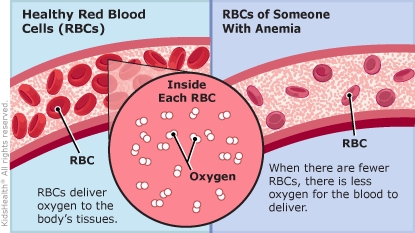Anemia happens when a person does not have enough red blood cells. Red blood cells deliver oxygen throughout the body. If there aren't enough red blood cells, oxygen can't get to the body's organs and then the organs don't work properly. This can lead to pale skin, lightheadedness, headaches, tiredness, and other symptoms.
There are several different causes of anemia. Your health care provider will treat your child based on what is causing their anemia.

Follow your health care provider's instructions for:
- Going for any blood tests.
- Medicines or vitamins to give.
- What activities to avoid:
- Most children with anemia can play and participate in sports as they usually do, but some may need extra rest.
- Food to offer and any changes in diet needed:
- Give your child a well-balanced diet with foods from all five food groups: vegetables, fruits, protein, grains, and dairy.
- Whether your child needs to see a hematologist (a specialist for blood problems).
- When to schedule a follow-up for your child.

Your child has signs that the anemia is getting worse, such as:
- Trouble breathing or very fast breathing
- Fainting or passing out

Why is anemia a problem? Red blood cells carry hemoglobin (HEE-muh-glow-bin), a protein that delivers oxygen throughout the body. If there aren't enough red blood cells, then the hemoglobin can't get the oxygen to the body's organs and the organs don't work properly. Since the organs aren't working properly, symptoms of anemia develop.
What are the symptoms of anemia? If the anemia is mild or develops slowly over time, some children don't have any symptoms. A child who does have symptoms might:
- Look pale
- Seem moody
- Be very tired
- Feel dizzy or lightheaded
- Have headaches
- Have a fast heartbeat
- Have jaundice (yellow skin and eyes), an enlarged spleen, and dark tea-colored pee (in hemolytic anemias)
Certain types of anemia can cause developmental delays and behavioral problems.
What causes anemia? There are several causes of anemia, including:
- When red blood cells are made too slowly. This can happen when someone doesn't have enough iron or the vitamins B12 or folate in their diet, or when the body stops making red blood cells because of illness or infection.
- When red blood cells get broken down too fast, called hemolytic anemias. These include autoimmune hemolytic anemia (when the body's immune system destroys its own red blood cells) and inherited hemolytic anemias (such as sickle cell disease).
- From bleeding. This can happen from an injury, heavy menstrual periods, the gastrointestinal tract, or another medical problem.




